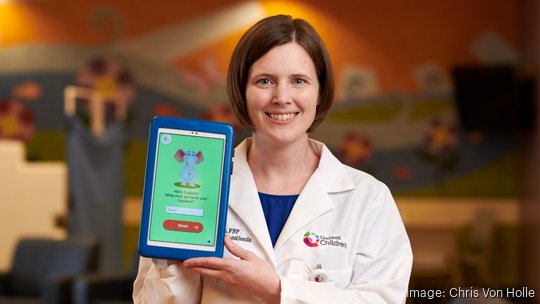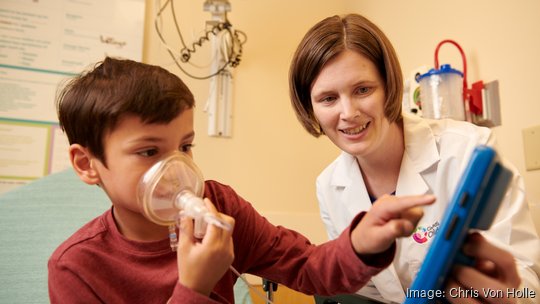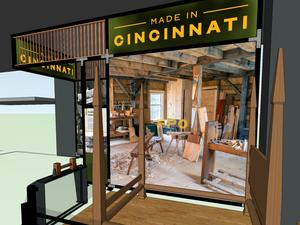
A video game invented by a nurse at Cincinnati Children’s Hospital hopes to reduce the level of anxiety kids experience when wearing anesthesia masks, and a newly inked licensing agreement could soon make the product available at hospitals around the world.
Abby Hess, a nurse practitioner and clinical researcher with medical center’s the department of anesthesiology, has spent the last seven years developing EZ Induction, a breathing-controlled video game to help kids relax when it’s time to put on an anesthesia mask and fall asleep for surgery.
Columbus-based LittleSeed Calming Technologies has now licensed the right to market the product to other hospitals. The firm is currently testing it with early adopters, with plans for a broader market introduction in the fourth quarter of 2023.
Cincinnati Children’s said the product could be a game changer for hospitals. The medical center itself handles more than 40,000 anesthetic cases annually, while on average, 3.9 million surgeries are performed on children 0-17 in the U.S. each year.
“I wanted to find a way to help kids feel calmer during this high-anxiety moment," Hess said.
Hess, who has been with Cincinnati Children’s for 17 years, came up with the idea for EZ Induction after watching young patients struggle with the anesthesia process.
Studies have also shown high anxiety before surgery is associated with poorer outcomes, and anesthesia can be a stressful experience for kids, parents and medical staff, she said. Many youngsters cry and resist the mask despite other interventions used — ranging from child life specialists who employ toys or videos to calming medications.
Hess said the game has flipped the script.
EZ Induction, a tablet-based app, transforms the anesthesia mask into a game controller. Children can move the cartoon animals — and win different challenges — by breathing calmly into it.
Now, through play, kids can familiarize themselves with the mask in the pre-operative area, then complete the final level in the operating room before going to sleep.

EZ Induction is geared for kids ages 3-10. Hess said new levels have been created to make the game more challenging for the older demographic.
“We've had so many kids almost positively anticipating this, and they’re excited (asking), ‘Where's the doctor?’ ‘Is it time to go back for my surgery yet?’ ‘I want to see the last level of the game.’ ‘How many points am I going to get?’” Hess said.
“That's been the most rewarding part of this project — to see kids use it and hear that feedback from parents,” she added. “Some parents have shared, “I had a difficult induction experience when I was young, and I didn't want that for my child.’”
Ready for commercialization
To date, Hess has received more than $400,000 in total grant funding to build out her idea, including initial financial support in 2016 from Cincinnati Children’s Innovation Ventures, the medical center’s tech transfer and commercialization group.
Children’s was also the first to pilot the EZ product back in 2018.
Additional funds have been awarded by the Center for Clinical & Translational Science, which is affiliated with the University of Cincinnati; Johnson & Johnson, via its “Innovate QuickFire Challenge;” and the state of Ohio's Technology Validation and Startup Fund.
Hess said UC’s Live Well Collaborative also helped develop the design for the game. “They helped us figure out how this was going to fit into a super-fast paced medical environment,” she said. “In an operating room, you have minutes to be able to ingrate things into that environment; it needed to be something that didn’t complicate the workflow.”
LittleSeed, more recently, has further refined the concept to ready it for commercialization.
For LittleSeed, this marks its first licensing deal with Cincinnati Children’s, said Jeff Penka, who co-founded the firm in 2017. LittleSeed acts as an incubator group and has signed similar agreements with Nationwide Children’s Hospital and has other projects in various stages of development.
All are considered “novel solutions” in the health care and education space, he said. It's also developing Voyager, a virtual reality experience to help kids who have anxiety when it comes to needle sticks and infusions.
EZ Induction fits its portfolio for many reasons, he said. The app is “engaging and fun application” and puts children and families at ease in an unfamiliar environment.
“When it comes to anxiety, the way a child goes under (anesthesia) is often related to the way they come out — if they're going in highly anxious, kicking and screaming, if adults are having to hold them down, they’re going to have a very unsettled experience as they're coming back, too,” he said. “If we can use something like EZ Induction to help them feel comfortable with the idea of breathing through a mask…it leads to a better experience. If you can reduce the likelihood of having to intervene with sedation, you're saving time, you're saving money.”
For Hess, she has other inventions in mind. The process of creating EZ Induction has "sparked" her passion for innovation.
She said she wants to create better systems for nurses and other clinicians to similarly develop their ideas.
Cincinnati Children’s is the region’s second-largest employer, with a staff of 17,300. Nearly a third are involved in research. At any given time, Innovation Ventures has about 500 projects in its pipeline, its Vice President Abram Gordon said, from vaccines to new therapeutics or digital solutions.
Hess’ product is one example of the medical center’s overall creative culture, he said.
“People may not realize that Cincinnati Children’s is a hub for medical innovation,” Gordon said in a release. “Researchers, clinicians and those on the front lines such as nurse practitioners think of creative ideas that often turn into improved care for our patients.”








